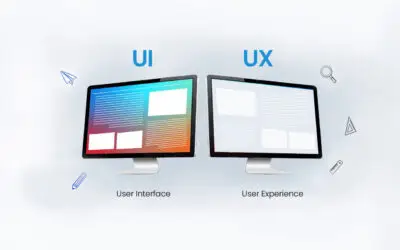Are you tired of struggling with awkward websites or confusing apps? When it comes to creating perfect digital experiences, it is all about UI/UX design. This often overlooked field is the backbone of every successful digital product, from your favorite social media platform to the apps you use daily.
Imagine a world where every digital interaction is intuitive, effortless, and even enjoyable. That is the power of good UI/UX design. However, what is it exactly and why is it important? Whether you are a budding designer, a curious tech enthusiast, or a business owner looking to enhance your digital presence, understanding the basics of UI/UX design is crucial in today’s digital world.
In this comprehensive guide, we will dive into the fundamental principles of UI/UX design, exploring everything from essential design concepts to practical tools and workflows. Get ready to unlock the secrets behind user-friendly interfaces and exceptional user experiences that keep people coming back for more.
Understanding UI/UX Design
In the rapidly evolving digital landscape, User Interface (UI) and User Experience (UX) design have become crucial elements in creating successful digital products. These interconnected disciplines form the foundation of how users interact with and perceive digital interfaces. Let’s delve into the fundamentals of UI/UX design, exploring their definitions, differences, and the significance of user-centered design approaches.
A. Defining UI and UX
User Interface (UI) Design
The interactive and visual aspects of a digital product are the main the spotlight of user interface design. It encompasses the look, feel, and interactivity of the user-facing components of a website, application, or any digital interface. UI designers are responsible for creating aesthetically pleasing and functional interfaces that users can easily navigate and interact with.
Key aspects of UI design include
- Visual Design: Creating graphical elements like buttons, icons, fonts, color schemes, and overall layouts is known as visual design.
- Interaction Design: This focuses on how users interact with the interface, including animations, transitions, and responsive elements.
- Information Architecture: This deals with the organization and structure of content within the interface.
UI design aims to create interfaces that are:
- Visually appealing
- Intuitive to use
- Consistent across different screens and devices
- Aligned with the brand identity
User Experience (UX) Design
User Experience design, on the other hand, is a broader discipline that encompasses the entire journey of a user’s interaction with a product or service. UX design considers all aspects of the user experience, including their emotions, perceptions, and practical interactions. Creating products that offer customers relevant and meaningful experiences is the primary goal of UX design.
Key components of UX design include:
- User Research: Gathering insights about user needs, behaviors, and pain points.
- Information Architecture: Organizing and structuring content to facilitate easy navigation and understanding.
- Interaction Design: Designing how users interact with the product and how it responds to their actions.
- Usability testing: Assessing how easy it is to use the product and highlighting areas that need work.
- User Journey Mapping: Visualizing the entire process a user goes through when interacting with a product.
The goal of UX design is to produce outcomes that are:
- Useful: Meeting user needs and solving their problems
- Usable: Simple to understand and operate
- Desirable: Activating relaxation and happy feelings
- Accessible: Meeting the requirements and abilities of a diverse range of users
- Credible: Increasing confidence and trust in the brand or product
B. Key differences between UI and UX
While UI and UX design are closely related and often work hand in hand, there are several key differences between the two disciplines:
Scope and Focus:
UI Design: Primarily concentrates on the visual and interactive aspects of a product’s interface.
UX Design: Takes a holistic approach, considering the entire user journey and all touchpoints with the product.
Process and Methodology:
UI Design: Typically involves creating visual elements, layouts, and interactive components.
UX Design: Detailed user research, testing, and iterative design procedures are parts of it.
Skills and Expertise:
UI Design: Strong proficiency in typography, color theory, and graphic design is common among UI designers.
UX Design: For this, designers require a diverse skill set, including user research, psychology, information architecture, and analytical thinking.
Deliverables:
UI Design: Designers produce visual assets such as mockups, prototypes, and style guides.
UX Design: Designers create user personas, journey maps, wireframes, and user flow diagrams.
Metrics and Evaluation:
UI Design: Their success is often measured by visual appeal, consistency, and ease of use.
UX Design: Task completion rates, overall user engagement, and user satisfaction are used to assess the performance of UX design.
Timing in the Design Process:
UX design: Typically comes first, establishing the product’s structure and functionality.
UI design : Follows, bringing the UX concepts to life through visual and interactive elements.
User Involvement:
UX Design: Heavily involves users throughout the process, from research to testing.
UI Design: May involve users in later stages for feedback on visual elements and interactions.
It’s important to note that while these differences exist, the lines between UI and UX design can often blur, especially in smaller teams or projects where designers may take on both roles.
C. The importance of user-centered design
User-centered design is a philosophy and methodology that places the needs, wants, and limitations of end-users at the forefront of the design process. This approach is crucial in creating products that not only look good but also provide meaningful and satisfying experiences. Here’s why user-centered design is essential in UI/UX design:
Enhanced User Satisfaction
By focusing on user needs and preferences, products become more intuitive and enjoyable to use.
This leads to higher user satisfaction, which can translate into increased loyalty and positive word-of-mouth recommendations.
Improved Usability and Accessibility
User-centered design ensures that products are easy to use for a wide range of users, including those with disabilities.
The approach assists in the development of user interfaces that are more diverse and reachable by a wider range of users.
Reduced Development Costs
Redesigns and modifications that are expensive can be avoided by paying attention to user demands early in the design process.
User testing throughout the development cycle helps catch issues before they become expensive problems.
Increased Adoption and Engagement
Products that meet user needs and expectations are more likely to be adopted and used regularly.
Higher engagement rates can lead to better retention and, in the case of commercial products, increased revenue.
Competitive Advantage
In a crowded market, user-centered design can set a product apart from competitors.
Products that prioritize user needs often gain a reputation for quality and reliability.
Alignment with Business Goals
User-centered design helps ensure that products not only meet user needs but also align with business objectives.
Businesses can decide on product features and marketing tactics using knowledge of customer behaviors and preferences.
Continuous Improvement
The iterative nature of user-centered design promotes ongoing refinement and improvement of products.
Constant feedback from users and testing enable the continual improvement of the user experiences.
Fundamental UX Design Concepts
Let’s delve into the fundamental concepts of UX design. These concepts form the backbone of creating user-centered experiences that are both intuitive and satisfying.
1: Wireframing and Prototyping
Wireframing and prototyping are crucial steps in the UX design process, serving as visual representations of a product’s structure and functionality before the final design is implemented.
Wireframing
Wireframes are low-fidelity sketches or digital representations of a product’s layout. They focus on:
- Content placement
- Information hierarchy
- Functionality
- User flow
Benefits of wireframing include:
- Quick visualization of ideas
- Easy iteration and experimentation
- Cost-effective testing of concepts
- Improved communication with stakeholders
Prototyping
Prototypes are working models of the finished product that let designers test features and user interfaces. They can range from low-fidelity paper prototypes to high-fidelity digital versions.
Types of prototypes
- Paper prototypes
- Click-through prototypes
- Interactive digital prototypes
- Functional prototypes
Benefits of prototyping:
- Early detection of usability issues
- User testing before development
- Stakeholder alignment
- Reduced development costs
When creating prototypes, consider:
- Fidelity level appropriate for the project stage
- Specific interactions to test
- Target audience for feedback
- Time and resources available
2: Information Architecture
Information architecture is the structural design of shared information environments. It involves organizing, labeling, and structuring content in an effective and sustainable way.
Key components of information architecture:
- Organization schemes and structures
- Labeling systems
- Navigation systems
- Search systems
Organization Schemes
Organizational schemes specify the categories and displays of information.
Common types include:
- Hierarchical: Top-down structure
- Sequential: Step-by-step organization
- Matrix: Multiple ways to access information
- Database: Structured data storage
Labeling Systems
Good labeling guarantees that users can understand and explore content with ease.
Best practices include:
- Using clear, concise language
- Maintaining consistency across the site
- Avoiding jargon or technical terms
- Considering cultural and linguistic differences
Navigation Systems
Navigation systems assist users in moving through the information.
Common navigation patterns include:
- Global navigation
- Local navigation
- Contextual navigation
- Supplementary navigation
Search Systems
Search functionality is crucial for large or complex information spaces.
Considerations for effective search systems include:
- Robust search algorithms
- Faceted search options
- Auto-suggest features
3: Journey Mapping
Journey mapping is a visual representation of a user’s experience with a product or service over time. It assists in identifying pain points, opportunities, and places for development in the user experience.
Steps to create a journey map:
- Define the scope and user persona
- Identify touchpoints and channels
- Map out user actions, thoughts, and emotions
- Highlight pain points and opportunities
- Analyze and prioritize improvements
Components of a journey map:
- User persona
- Timeline or stages
- Actions and behaviors
- Thoughts and emotions
- Pain points and opportunities
- Touchpoints and channels
Benefits of journey mapping:
- Identifies gaps in the user experience
- Aligns teams around user needs
- Prioritizes improvement efforts
- Provides context for design decisions
Best practices for journey mapping:
- Use real data and user research
- Involve cross-functional teams
- Keep the map visually engaging
- Update regularly based on new insights
- Use the map to inform design decisions
4: Creating User Personas
User personas are fictionalized depictions of ideal users based on study and data. They enable designers to empathize with people and make knowledgeable design decisions.
Steps to create user personas:
- Conduct user research
- Identify patterns and commonalities
- Create persona segments
- Develop detailed persona profiles
- Validate and refine personas
Components of a user persona:
- Name and photo
- Demographics
- Goals and motivations
- Pain points and frustrations
- Behaviors and preferences
- Quotes or narratives
Benefits of user personas:
- Improved user empathy
- Focused design decisions
- Consistent user experience
- Effective communication with stakeholders
- Prioritization of features and improvements
Best practices for creating personas:
- Base personas on real data, not assumptions
- Keep personas concise and relevant
- Update personas regularly
- Use personas throughout the design process
- Create multiple personas to represent diverse user groups
5. User Research Methods
User research is the foundation of effective UX design, providing insights into user needs, behaviors, and preferences. Various methods can be employed to gather this crucial information.
Qualitative Research Methods
1: Interviews
- One-on-one conversations with users
- Provides in-depth insights into user thoughts and motivations
- Types: structured, semi-structured, unstructured
2: Focus Groups
- Group discussions with 6-10 participants
- Generates diverse opinions and ideas
- Useful for exploring new concepts or features
3: Contextual Inquiry
- Observing users in their natural environment
- Provides insights into real-world usage and pain points
- Combines observation with interviews
4: Usability Testing
- Evaluates product usability through task completion
- Identifies usability issues and areas for improvement
- Can be conducted remotely or in-person
Quantitative Research Methods
1: Surveys
- Gathers data from a huge number of users.
- Useful for gathering statistical data and trends
- Can be conducted online or in-person
2: A/B Testing
- Compare two variations of a design to see which performs better.
- Provides data-driven insights for design decisions
- Requires sufficient sample size for statistical significance
3: Analytics
- Analyzes user behavior data from digital products
- Provides insights into usage patterns and trends
- Tools: Google Analytics, Mixpanel, Hotjar
4: Card Sorting
- Helps understand how users categorize information
- Useful for developing information architecture
Can be conducted open (users create categories) or closed (predefined categories)
By mastering these fundamental UI/UX design concepts, designers can create more effective, user-centered products. Wireframing and prototyping allow for rapid iteration and testing of ideas. Information architecture ensures content is organized logically and accessibly. Journey mapping can assist find areas for enhancement in the user experience. User personas guide design decisions by keeping the focus on user needs. Finally, user research methods provide the data and insights necessary to inform all aspects of the design process.



